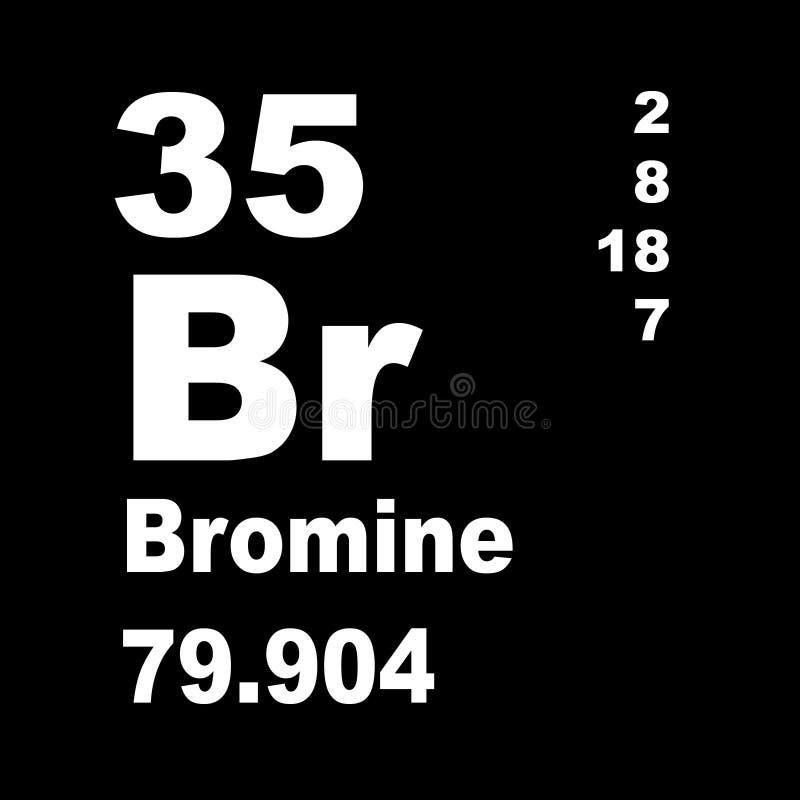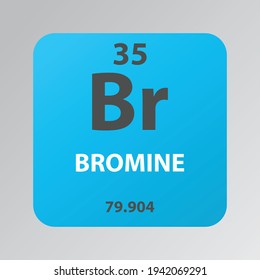Br ATOMIC NUMBER 35 ATOMIC MASS 79.904 FAMILY Group 17 (VIIA) Halogen PRONUNCIATION BRO-meen Nearly 90 percent of all bromine produced comes from the United States. Bromine, atomic structure. Here are electron shell atom diagrams for the elements, ordered by increasing atomic number. For each electron shell atom diagram, the element symbol is listed in the nucleus. The electron shells are shown, moving outward from the nucleus.

Bromine (Br) is a red brown liquid non metal. It has the atomic number 35 in the periodic table. It is located in Group 17, the Halogens. It has the symbol Br. Bromine: Symbol: Br: Atomic Number: 35: Atomic Mass: 79.904 atomic mass units: Number of Protons: 35: Number of Neutrons: 45: Number of Electrons: 35: Melting Point-7.2° C: Boiling Point. Approximately 500 million kilograms of bromine are produced worldwide in a year. Common Uses: Brominated vegetable oil; Citrus flavored soft drinks. Atomic Structure of Bromine; Chemical Properties of Bromine; Physical Properties of Bromine; Regulatory / Health; Who/When/Where/How. Bromine Page Two. Nuclides / Isotopes; Potential Parent Nuclides. Bromine Page Three. Common Chemical Compounds of Bromine. Overview of Bromine. Atomic Number: 35; Group: 17; Period: 4; Series: Halogens.
Chemical properties of bromine - Health effects of bromine - Environmental effects of bromine
|
BromineAt ambient temperature bromine is a brownish-red liquid. It has a similarly colored vapor with an offensive and suffocating odor. It is the only nonmetallic element that is liquid under ordinary conditions, it evaporates easily at standard temperature and pressures in a red vapor that has a strong disagreeable odor resembling that of chlorine. Bromine is less active chemically than chlorine and fluorine but is more active than iodine; its compounds are similar to those of the other halogens. Bromine is soluble in organic solvents and in water. ApplicationsBromine is used in industry to make organobromo compounds. A major one was dibromoethane an agent for leaded gasoline, before they were largely phased out due to environmental considerations. Other organobromines are used as insecticides, in fire extinguishers and to make pharmaceuticals. Bromine is used in making fumigants, dyes, flameproofing agents, water purification compounds, sanitizes, medicinals, agents for photography and in brominates vegetable oil, used as emulsifier in many citrus-flavoured solft drinks. Bromine in the environmentBromine is a naturally occurring element that can be found in many inorganic substances. Humans however, have many years ago started the introduction of organic bromines in the environment. These are all compounds that are not natural and can cause serious harm to human health and the environment. In diffuse crustal rock bromine naturally occurs as bromide salts. Bromine salts have accumulated in sea water (85 ppm), from which bromine is extracted. Health effects of bromine
Environmental effects of bromine
Back to periodic chart. |
More from 'Elements'
Lenntech (European Head Office)
Distributieweg 3
2645 EG Delfgauw
The Netherlands
Phone: +31 152 610 900
fax: +31 152 616 289
e-mail: info@lenntech.com

Lenntech USA LLC (Americas)
5975 Sunset Drive
South Miami, FL 33143
USA
Phone: +1 877 453 8095
e-mail: info@lenntech.com

Lenntech DMCC (Middle East)
Level 5 - OFFICE #8-One JLT Tower
Jumeirah Lake Towers
Dubai - U.A.E.
Phone: +971 4 429 5853
e-mail: info@lenntech.com
Bromine Atomic Number 35
What Is Bromine

Bromine Atomic Number Number
Copyright © 1998-2021 Lenntech B.V. All rights reserved
